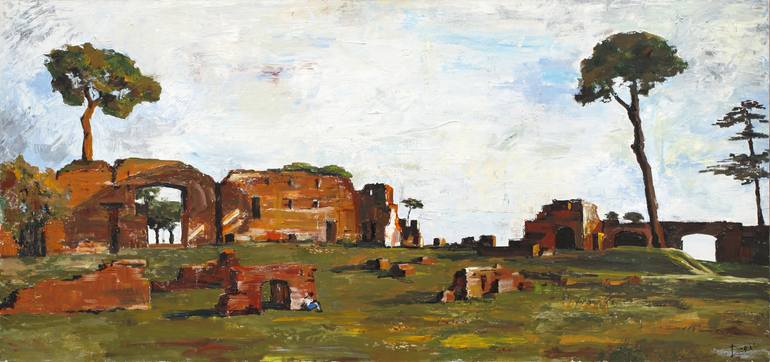





VIEW IN MY ROOM
Palatine Hill in Rome, Italy Painting
United States
Painting, Acrylic on Canvas
Size: 66.9 W x 31.5 H x 2 D in
Ships in a Tube
Shipping included
14-day satisfaction guarantee
Artist Recognition

Artist featured in a collection
About The Artwork
I wanted to convey with this picture, the beauty and tranquility of the ancient ruins of Rome. The Palatine Hill is the centermost of the Seven Hills of Rome and is one of the most ancient parts of the city. It stands 40 metres above the Roman Forum, looking down upon it on one side, and upon the Circus Maximus on the other. It is the etymological origin of the word palace and its cognates in other languages (Italian palazzo, French palais, German Palast, Czech palác, etc.). According to Roman mythology, the Palatine Hill was the location of the cave, known as the Lupercal, where Romulus and Remus were found by the she-wolf Lupa that kept them alive. According to this legend, the shepherd Faustulus thereafter found the infants, and with his wife Acca Larentia raised the children. When they were older, the boys killed their great-uncle (who seized the throne from their grandfather), and they both decided to build a new city of their own on the banks of the River Tiber. Suddenly, they had a violent argument with each other and in the end Romulus killed his twin brother Remus. This is how "Rome" got its name - from Romulus. Another legend to occur on the Palatine is Hercules' defeat of Cacus after the monster had stolen some cattle. Hercules struck Cacus with his characteristic club so hard that it formed a cleft on the southeast corner of the hill, where later a staircase bearing the name of Cacus was constructed.
Details & Dimensions
Painting:Acrylic on Canvas
Original:One-of-a-kind Artwork
Size:66.9 W x 31.5 H x 2 D in
Frame:Not Framed
Ready to Hang:Not applicable
Packaging:Ships Rolled in a Tube
Shipping & Returns
Delivery Time:Typically 5-7 business days for domestic shipments, 10-14 business days for international shipments.
Handling:Ships rolled in a tube. Artists are responsible for packaging and adhering to Saatchi Art’s packaging guidelines.
Ships From:United States.
Have additional questions?
Please visit our help section or contact us.
United States
Daria Bagrintseva is a world known contemporary artist, winner of 19 international awards in the field of art. Daria's paintings were acquired for the permanent collection of the State Russian Museum in St. Petersburg, Russia. Daria was born in Moscow and is currently based in Miami. A Master of Fine Arts, she studied in Italy, Russia, and the USA. The American magazine ‘Art Business News’ recognized Daria as one of the Top 50 Emerging Artist of the World in 2012. She is the author of the unique methodology of teaching creativity and painting for adults and children. Daria's solo exhibitions took place in more than 20 countries, and she was a Member of Art Basel Art Week in Miami 2012, 2016 and 2019. Daria has also exhibited her work as one of the selected emerging artists in the Louvre, Paris, 2011 and in the castle of Pierre Cardin on the Champs Elysees. In 2016. Her works are in private collections in Russia, USA, Germany, France, Switzerland, Italy, Spain, Norway, Denmark, Holland, Cyprus, and India. Daria has appeared in over 100 printed publications, her paintings found a home in prestigious private collections all over the world, and over 500 of her paintings have been sold. www.dariart.com
Artist Recognition

Artist featured by Saatchi Art in a collection
Thousands Of Five-Star Reviews
We deliver world-class customer service to all of our art buyers.
Global Selection
Explore an unparalleled artwork selection by artists from around the world.
Satisfaction Guaranteed
Our 14-day satisfaction guarantee allows you to buy with confidence.
Support An Artist With Every Purchase
We pay our artists more on every sale than other galleries.
Need More Help?